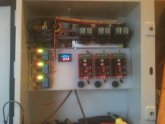Latching relays stay in the state you put them in,
It takes a power pulse, then an 'Off', then back to powered to change the state, open and close the contacts inside.
They change state (open to closed, or closed to open) and stay there until an 'Off' cycle happens, and a second power pulse gets to them.
For instance,
A 'Beeper' won't work, just keeps switching the latching relay On/Off.
BUT,
A continuous light that just goes off when the problem corrects itself WILL work, without the second 'On' pulse the latching relay will stay in state without a second power pulse.
The light coming 'On', and staying on is one continuous power pulse, and when the light goes 'Off', it just completes the first cycle pulse cycle, and it takes a second power pulse to change the state of the relay to make it go back to where it was before the first 'On/Off' pulse cycle.
That would be you pushing the manual cycle button built onto the board with the little $5 units.
View attachment 4811
While I didn't draw in the battery, the battery supplies the power to activate the relays, while the panels are independent circuits.
I also didn't draw in the signal generator, BMS, Over Voltage or Under Voltage sensors, etc because the signal generator can be anything, from an over or under volt light on the charge controller to a smoke detector/fire alarm, the latching relay doesn't care where the signal power comes from.
At my house, the main disconnect relays are wired to a latching relay, which in turn are wired to the smoke detector.
A second over temp sensor set at 110*F turns on the sprinklers, the two interlock.
Smoke everything gets shut down with exception of the protection system, and 110*F AND the smoke detector going off, the sprinklers go off.
I'm earth sheltered, and if there is smoke AND the temp ever gets above about 80*F there
IS a fire!
My well water pressure tanks hold about 300 gallons, which will be sprinkled on the now disconnected power power equipment, the only thing running will be protection system connected directly to batteries.
(FLOOR DRAIN RECOMMENDED!)
*IF* you have stepped fully into the 20th century and have DIN rail boxes,
This will give you the idea, but I'm NOT saying this will work for your particular application.
*IF* it were me, I'd use a separate relay for panel Positive & Negative strings, this will stop the differential problem and stop any arc over in it's track over using a Double Pole relay for Positive & Negative.
The Latching relay can easily handle two separate power relays.
https://www.ebay.com/itm/GEYA-Memor...hash=item1a58c769d9:m:mb_GyIzOiMt7acMormjowag
View attachment 4812
This is 6 Channels of latching relays ganged (6 isolated panel strings through power relays) for $12
https://www.ebay.com/itm/6-Channel-12V-Latching-Relay-Module-Switch-Controls-the-High-Voltage-H-Current/133264217588?_trkparms=aid=555018&algo=PL.SIM&ao=1&asc=20131003132420&meid=a39b033b17234fd091218c92713db677&pid=100005&rk=1&rkt=12&mehot=co&sd=121951095953&itm=133264217588&pmt=1&noa=0&pg=2047675&_trksid=p2047675.c100005.m1851
Single Channel for $3
1 Channel Latching Relay Module. Press the trigger button, the relay is locked, press again, the relay off, you can also add the trigger switch, and the use of low-level trigger. 1x 1 ChannelSelf-locking Relay Module.
www.ebay.com
---------------------------
PERSONAL 'OPINION'/CHOICE WARING.
I
STRONGLY DISLIKE 'Computer Controlled' or 'Digital' anything in safety systems.
I've had my go-arounds with Transient RF & EM signals (line switching noise in particular, running motors and circuits opening/closing) and I went with hard wired, ANALOG protection on a dedicated circuit.
With a water valve in the sprinkler line, I can cut the water to the sprinkler solenoid and test any part of the system without an umbrella and water damage...
YOU do what you think is best for you. Some people want to use the integrated home management systems ('Smart' Homes), that's their choice.
I started with a 'Home Protection Kit' that backup battery on the board I didn't know existed triggered the sprinklers...
I no longer have a 'Home Protection Kit', I beat it off the wall with a hammer.
Dark House, flooded room, and that 'Low Batt' light, 'Security, & 'Fire' red lights that normally indicated the fire/window/door alarm sensors still on, I SNAPPED...








